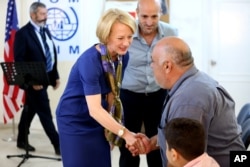With two weeks remaining in the U.S. fiscal year, refugee aid agencies around the country are in the middle of what is projected to be one of the busiest months for arrivals in at least a decade, following a surge to bring in more Syrians fleeing civil war and Islamic State militants.
As of September 15, nearly 79,000 refugees from 78 countries have come to the U.S. since October 1, 2015, a figure that hasn’t been reached in 17 years, according to official data.
The U.S. refugee program, which is run by several federal agencies, including the State Department, still expects to reach the target of 85,000 arrivals by the end of this month.
“We’ve set a goal for 85,000 and that's where we're going to shoot, and that's where I think we're going to end up,” Mark Storella, deputy assistant secretary at the Bureau of Population, Refugees and Migration, told VOA this week.
Plenty of plane tickets
Michel Tonneau, global program coordinator of the U.S. refugee program at the International Organization for Migration’s Washington bureau, said his agency had booked enough plane tickets for the targeted number of refugees. September is frequently a peak time for arrivals as the federal government closes out its budget for the year and the refugee program tries to get close to the designated ceiling without exceeding it.
"It’s a remarkable year. I've been in this program for probably 30 years. I do not recall we've ever been able to match the admission level number,” Tonneau said.
The actual number of refugees often falls just shy of the target, as was the case last year, when the ceiling decided by the president in collaboration with the State Department was 70,000 refugees and the country admitted 69,933.
As Europe struggled to process hundreds of thousands of refugees and asylum-seekers in 2015, the Obama administration announced an increase in the number of refugees the U.S. would accept for resettlement in fiscal 2016 to 85,000 from 70,000. The decision, which included the goal of 10,000 Syrian refugees, placed increased pressure on local groups that help the newcomers.
'Crazy' months
As those Syrian families filtered through an expedited processing system in Jordan, the summer months saw a jump in arrivals.
“July and August were so crazy. We definitely felt the push,” said Aerlande Wontamo, regional director for Lutheran Social Services of the National Capital Area. The group finds immediate housing for refugee families, picks them up at the airport, helps enroll children in school and supports their adjustment to a new home country.
They and other resettlement groups say they can meet the demand of additional refugees and have advocated for an increase to as high as 200,000.
The government originally set a goal of 100,000 for the coming fiscal year, which begins October 1. Media reports this week have indicated the president will raise that target to 110,000.
“We’re excited to hear more refugees are going to be coming,” said Wontamo. “That’s a great need.”
Relatively few relocated
Though the U.N. refugee agency registered 16.1 million refugees in 2015, only about 107,000 of those individuals were relocated to so-called third countries that volunteer to take in the displaced, like the U.S., Canada and Australia. There are simply too few offers to match the needs of people who cannot go back to their home countries and cannot stay in their asylum countries.
Bill Canny, who heads migration and refugee services for one of the country’s longest-serving resettlement agencies, the U.S. Conference of Catholic Bishops, believes the current effort is just not good enough.
“Those figures are incredibly low relative to need,” Canny said. “We can all do better, including the United States.”
VOA State Department correspondent Nike Ching contributed to this report.










